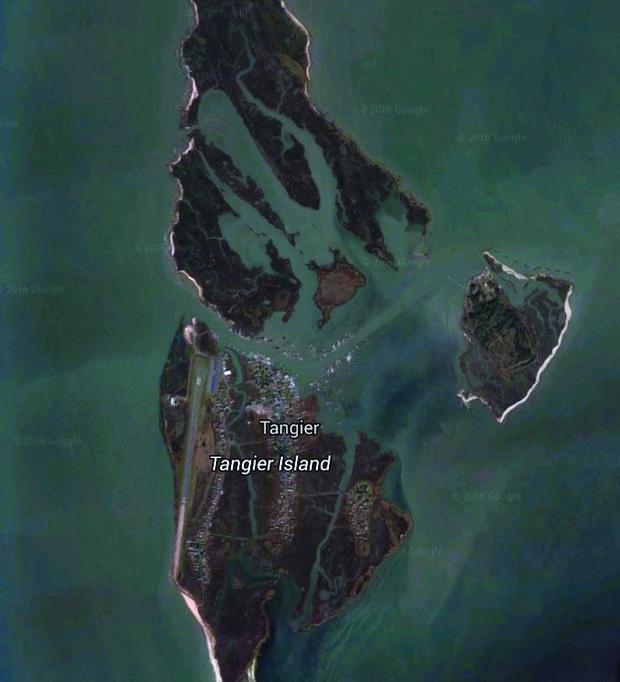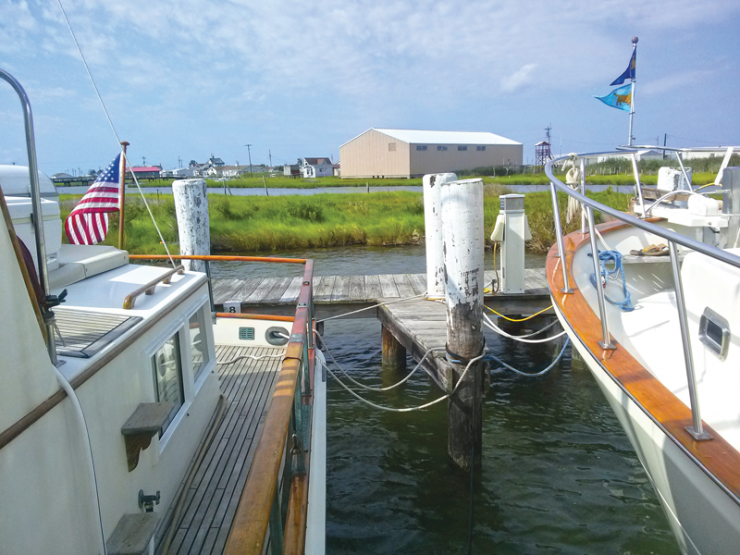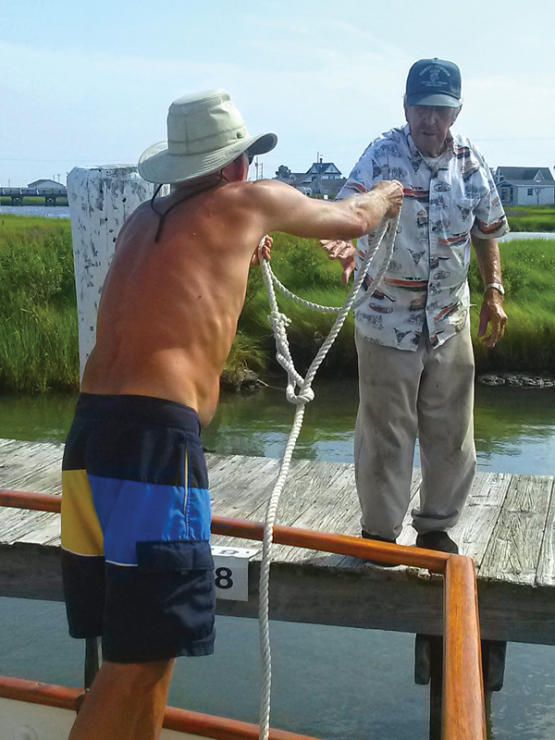
Last summer we pulled into Tangier Island for a few days. This old watermen’s community is thriving on tourism and holding tight to its population of watermen and their way of life. I had a couple of hours of boat ride ahead of me when we left, and I so wanted to try to depict the feel of the place. I started writing about the setting and the views but just couldn’t tease it out, and then found the place was better captured in its people. The place is beautiful, but it lives in its people.
If you arrive by personal boat, your first impression of Tangier Island will be Milton Parks. The Parks Marina is the only game in town, and Milton takes a very hands-on approach to operating his marina. He’s well into his 80s and happy to tell you all the stories of all his years. He grew up on the island and has lived his whole life there, except for a stint in the Navy. He built and started the marina business only when he got “too old” to be a waterman. He’s on his own these days, so it’s a one-man operation. When arranging to pull in there, be prepared to get no response back to your radio calls, as he may be out and about running his marina. You may have to arrive without knowing which slip you’re pulling into, but you can be sure that when you arrive, he’ll be there to help with lines and start in on his stories.
After you’ve tied up, Milton will direct you along the path from the marina, which leads right up through the main road of town where you’ll find the island’s general store, a few restaurants, golf car rental for tourists off the ferry, and around the corner the new medical clinic. There’s also a museum and a nice new school on the island.

Tangier Island’s central thoroughfare is not a road or even a wide sidewalk; it’s the waterway. After cruising into the island through the channel lined with waterman’s shanties, we sat on our bridge, facing the “main thoroughfare,” watching the town’s life move up and down. The folks moved along the waterway doing their work, stopping to chat with their neighbors, taking kids to friend’s houses or school, and experiencing their day-to-day lives on the water, the same way most folks experience their lives on roads and sidewalks. The dads and granddads teach their trade and their way of life to their sons and daughters on the workboats. This is the village that it takes to raise a child; the place we all daydream about, where people still sit on their front porches, where people know all their neighbors and have lived for generations.
The morning after we arrived, we stood out on the deck with our morning tea and coffee and watched the day’s business happening up and down “Main Street.” Another boat was pulling in, a bigger, snazzier boat than ours, but these people are boat people and will always lend a hand; so the other boaters came out to help get her tied up. The boat used her bow and stern thrusters to move sideways into the dock because it was too big to fit in any of Milton’s slips. She was so maneuverable, she didn’t seem to need any people to help. One of the other first mates I stood with commented about how their first mate doesn’t seem to be rushing around the boat to get the lines in place and be ready to push off pilings. When the newest arrival was all tied up at the dock, I found myself pondering the variety of boats around me, everything from this 60-foot Nordhaven that could go anywhere in the world, to sailboats that have been plying the waters of the Chesapeake for 60 years, to our sturdy, older 36-foot Grand Banks that has become our home.

After the boat was tied up and things had settled down again, I resumed my spot in the sun on the bow and quietly read my book. I listened to the men at the back of the boat discussing boat stuff. Boat people instinctively stop and chat with other boat people. One man on his boat, another man standing on his boat, tied up next to her, and another man on the dock. Even Milton joined them for a time. They discussed make, engine size, and generators. They talked about the weather and how the wind was blowing. They talked about the tides and the current and what the water looked like.
The watermen’s shanties hold the history of each family who’s been plying these waters for generations. I wonder when the last time anyone new moved to this island. It used to be that nobody would move here, and most folks were leaving because there were no jobs here but now… People work over the internet and can live anywhere they choose. I wonder if somebody like that might choose to live here? I can imagine myself choosing to live here for a time.
After you’ve explored the commercial part of the island, you’ll want to trek out to the beach. Up the road from the island’s new medical clinic, you’ll turn left onto the road that goes out to their long, beautiful beach. It’s undeveloped and refreshingly undisturbed. It was easy to spend hours walking on the shore, which looks southeast across the Chesapeake and has some of the most breathtaking sunset views our little group had witnessed. As we stood with our toes on the sand, we watched the sky blaze with sunset colors. We’d be pulling out first thing in the morning, and we all agreed we wanted to come here again.
About the Author: Elizabeth Kelch writes about boating and environmental issues from the Grand Banks 36
In No Hurry.
 Last summer we pulled into Tangier Island for a few days. This old watermen’s community is thriving on tourism and holding tight to its population of watermen and their way of life. I had a couple of hours of boat ride ahead of me when we left, and I so wanted to try to depict the feel of the place. I started writing about the setting and the views but just couldn’t tease it out, and then found the place was better captured in its people. The place is beautiful, but it lives in its people.
If you arrive by personal boat, your first impression of Tangier Island will be Milton Parks. The Parks Marina is the only game in town, and Milton takes a very hands-on approach to operating his marina. He’s well into his 80s and happy to tell you all the stories of all his years. He grew up on the island and has lived his whole life there, except for a stint in the Navy. He built and started the marina business only when he got “too old” to be a waterman. He’s on his own these days, so it’s a one-man operation. When arranging to pull in there, be prepared to get no response back to your radio calls, as he may be out and about running his marina. You may have to arrive without knowing which slip you’re pulling into, but you can be sure that when you arrive, he’ll be there to help with lines and start in on his stories.
After you’ve tied up, Milton will direct you along the path from the marina, which leads right up through the main road of town where you’ll find the island’s general store, a few restaurants, golf car rental for tourists off the ferry, and around the corner the new medical clinic. There’s also a museum and a nice new school on the island.
Last summer we pulled into Tangier Island for a few days. This old watermen’s community is thriving on tourism and holding tight to its population of watermen and their way of life. I had a couple of hours of boat ride ahead of me when we left, and I so wanted to try to depict the feel of the place. I started writing about the setting and the views but just couldn’t tease it out, and then found the place was better captured in its people. The place is beautiful, but it lives in its people.
If you arrive by personal boat, your first impression of Tangier Island will be Milton Parks. The Parks Marina is the only game in town, and Milton takes a very hands-on approach to operating his marina. He’s well into his 80s and happy to tell you all the stories of all his years. He grew up on the island and has lived his whole life there, except for a stint in the Navy. He built and started the marina business only when he got “too old” to be a waterman. He’s on his own these days, so it’s a one-man operation. When arranging to pull in there, be prepared to get no response back to your radio calls, as he may be out and about running his marina. You may have to arrive without knowing which slip you’re pulling into, but you can be sure that when you arrive, he’ll be there to help with lines and start in on his stories.
After you’ve tied up, Milton will direct you along the path from the marina, which leads right up through the main road of town where you’ll find the island’s general store, a few restaurants, golf car rental for tourists off the ferry, and around the corner the new medical clinic. There’s also a museum and a nice new school on the island.
 Tangier Island’s central thoroughfare is not a road or even a wide sidewalk; it’s the waterway. After cruising into the island through the channel lined with waterman’s shanties, we sat on our bridge, facing the “main thoroughfare,” watching the town’s life move up and down. The folks moved along the waterway doing their work, stopping to chat with their neighbors, taking kids to friend’s houses or school, and experiencing their day-to-day lives on the water, the same way most folks experience their lives on roads and sidewalks. The dads and granddads teach their trade and their way of life to their sons and daughters on the workboats. This is the village that it takes to raise a child; the place we all daydream about, where people still sit on their front porches, where people know all their neighbors and have lived for generations.
The morning after we arrived, we stood out on the deck with our morning tea and coffee and watched the day’s business happening up and down “Main Street.” Another boat was pulling in, a bigger, snazzier boat than ours, but these people are boat people and will always lend a hand; so the other boaters came out to help get her tied up. The boat used her bow and stern thrusters to move sideways into the dock because it was too big to fit in any of Milton’s slips. She was so maneuverable, she didn’t seem to need any people to help. One of the other first mates I stood with commented about how their first mate doesn’t seem to be rushing around the boat to get the lines in place and be ready to push off pilings. When the newest arrival was all tied up at the dock, I found myself pondering the variety of boats around me, everything from this 60-foot Nordhaven that could go anywhere in the world, to sailboats that have been plying the waters of the Chesapeake for 60 years, to our sturdy, older 36-foot Grand Banks that has become our home.
Tangier Island’s central thoroughfare is not a road or even a wide sidewalk; it’s the waterway. After cruising into the island through the channel lined with waterman’s shanties, we sat on our bridge, facing the “main thoroughfare,” watching the town’s life move up and down. The folks moved along the waterway doing their work, stopping to chat with their neighbors, taking kids to friend’s houses or school, and experiencing their day-to-day lives on the water, the same way most folks experience their lives on roads and sidewalks. The dads and granddads teach their trade and their way of life to their sons and daughters on the workboats. This is the village that it takes to raise a child; the place we all daydream about, where people still sit on their front porches, where people know all their neighbors and have lived for generations.
The morning after we arrived, we stood out on the deck with our morning tea and coffee and watched the day’s business happening up and down “Main Street.” Another boat was pulling in, a bigger, snazzier boat than ours, but these people are boat people and will always lend a hand; so the other boaters came out to help get her tied up. The boat used her bow and stern thrusters to move sideways into the dock because it was too big to fit in any of Milton’s slips. She was so maneuverable, she didn’t seem to need any people to help. One of the other first mates I stood with commented about how their first mate doesn’t seem to be rushing around the boat to get the lines in place and be ready to push off pilings. When the newest arrival was all tied up at the dock, I found myself pondering the variety of boats around me, everything from this 60-foot Nordhaven that could go anywhere in the world, to sailboats that have been plying the waters of the Chesapeake for 60 years, to our sturdy, older 36-foot Grand Banks that has become our home.
 After the boat was tied up and things had settled down again, I resumed my spot in the sun on the bow and quietly read my book. I listened to the men at the back of the boat discussing boat stuff. Boat people instinctively stop and chat with other boat people. One man on his boat, another man standing on his boat, tied up next to her, and another man on the dock. Even Milton joined them for a time. They discussed make, engine size, and generators. They talked about the weather and how the wind was blowing. They talked about the tides and the current and what the water looked like.
The watermen’s shanties hold the history of each family who’s been plying these waters for generations. I wonder when the last time anyone new moved to this island. It used to be that nobody would move here, and most folks were leaving because there were no jobs here but now… People work over the internet and can live anywhere they choose. I wonder if somebody like that might choose to live here? I can imagine myself choosing to live here for a time.
After you’ve explored the commercial part of the island, you’ll want to trek out to the beach. Up the road from the island’s new medical clinic, you’ll turn left onto the road that goes out to their long, beautiful beach. It’s undeveloped and refreshingly undisturbed. It was easy to spend hours walking on the shore, which looks southeast across the Chesapeake and has some of the most breathtaking sunset views our little group had witnessed. As we stood with our toes on the sand, we watched the sky blaze with sunset colors. We’d be pulling out first thing in the morning, and we all agreed we wanted to come here again.
About the Author: Elizabeth Kelch writes about boating and environmental issues from the Grand Banks 36 In No Hurry.
After the boat was tied up and things had settled down again, I resumed my spot in the sun on the bow and quietly read my book. I listened to the men at the back of the boat discussing boat stuff. Boat people instinctively stop and chat with other boat people. One man on his boat, another man standing on his boat, tied up next to her, and another man on the dock. Even Milton joined them for a time. They discussed make, engine size, and generators. They talked about the weather and how the wind was blowing. They talked about the tides and the current and what the water looked like.
The watermen’s shanties hold the history of each family who’s been plying these waters for generations. I wonder when the last time anyone new moved to this island. It used to be that nobody would move here, and most folks were leaving because there were no jobs here but now… People work over the internet and can live anywhere they choose. I wonder if somebody like that might choose to live here? I can imagine myself choosing to live here for a time.
After you’ve explored the commercial part of the island, you’ll want to trek out to the beach. Up the road from the island’s new medical clinic, you’ll turn left onto the road that goes out to their long, beautiful beach. It’s undeveloped and refreshingly undisturbed. It was easy to spend hours walking on the shore, which looks southeast across the Chesapeake and has some of the most breathtaking sunset views our little group had witnessed. As we stood with our toes on the sand, we watched the sky blaze with sunset colors. We’d be pulling out first thing in the morning, and we all agreed we wanted to come here again.
About the Author: Elizabeth Kelch writes about boating and environmental issues from the Grand Banks 36 In No Hurry.